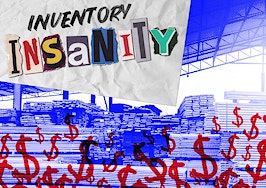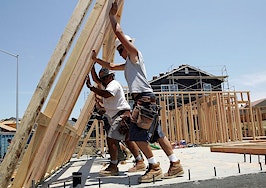 We want to help you make more money — right now. All month, go Back to Basics with Inman as real estate pros share what’s working now and how they’re setting up to profit in a post-pandemic world. Get full access to the series for 50 percent off here.
We want to help you make more money — right now. All month, go Back to Basics with Inman as real estate pros share what’s working now and how they’re setting up to profit in a post-pandemic world. Get full access to the series for 50 percent off here.
This article is adapted from Bill Ham’s book, Creative Cash: The Complete Guide to Master Lease Options and Seller Financing for Investing in Real Estate, taken with permission from the author.
Making money is usually part of the reason people go into the real estate business. However, being profitable isn’t as easy as finding a good deal and watching the money roll in.
If you want your real estate business to be profitable, you should always be looking for ways to improve your cash flow — and one of the best ways to do this is through better operations.
The idea is to find areas where you can create value by cutting expenses. But where do you start? In my experience, there are a number of ways you can cut expenses, and I’m going to share them with you here. With these tips, and some analysis on your part, you can expect to improve your cash flow — perhaps even significantly.
1. Repairs and maintenance costs
Try to bring these expenses down by shopping for better and cheaper contractors. Start by getting bids from local contractors. To get the best price, develop a relationship with these local service providers.
I like to find contractors who will give me a discount in exchange for my loyalty. I guarantee them all the work on the property (economy of scale) if they give me good service at a lower price.
Having a local team of loyal contractors will help you get offers accepted. By showing a seller you have a team to get the work done, your offer will seem more credible, and more of them will be accepted.
2. Payroll
My rule of thumb for employees on multifamily properties is to have two employees per 100 units. This is divided between office and maintenance staff.
Using this example of a 100-unit apartment complex, it should be staffed with what I call one in and one out. You need one employee in the office and one out on the property for each 100 units. The first 100 most likely require a property manager and a maintenance supervisor.
A 200-unit complex should have one property manager and an assistant manager. You’ll also likely need a maintenance manager and maintenance assistant. Most management companies tend to overstaff their properties. I’ve added thousands of dollars back into the cash flow of complexes by properly staffing them.
Some management companies also upcharge for employee costs. For example, if an employee makes $20 an hour, they may charge the owner $25 an hour. You need to know this information so you can cut expenses here.
3. Turn costs
This is the expense for making a unit ready for renting again after a tenant moves out. This cost will be decided by your contractors. You want to pay attention to the total amount spent each year on turn costs. This information will be in the financial data.
If you see high turn costs (not to be confused with regular repairs), then this means one of two things. Either management is paying its contractors too much, or the tenant base is unstable altogether.
If the managers are paying too much to turn a unit, then there may be opportunity to streamline the expenses. That’s good! If the turn costs are high, and they aren’t paying too much for each turn, then they are turning units too often. This means the tenants in the area/property move in and out on a regular basis. Tenant turnover is typically the highest expense on a property.
The longer a tenant lives in a unit, the more money you make. In most apartment markets, the average tenancy is two years. This means that on average, you will turn over about 50 percent of your apartments each year.
If you find that tenants move out (on average) less than every two years, you may have an economically challenged property with tenants who move too often for you to ever make any real money. Avoid deals with an unstable tenant base. It will be a management nightmare, and you won’t have the cash flow you are expecting.
4. Contract services
Contract services are services provided to the property on a regular or scheduled basis. This is slightly different from the general contractor repairs mentioned above.
Contract services include trash removal, landscaping, pest control and so on. You will likely be working with a company and not an individual contractor for these.
These services will likely be on a contract that may or may not survive the sale of the property. Look to see when these contracts are set to renew and begin your negotiations for new prices early on.
5. Office expenses
This is an area where you can save a ton of money and put cash back on the books. If an office rents its equipment, then you should compare the cost of buying the equipment versus leasing it.
I found one office that paid over $100 a month to rent the copier/fax machine. I priced comparable equipment at the local computer store and found I could buy similar equipment for about $1,000. In less than a year, we were saving money and owned the equipment.
Marketing costs can fall under this category as well. Make sure the property is utilizing all the free advertising it can before spending money on marketing. Make full use of the internet and social media before doing paid advertising.
Do some research to see what types of advertising have been effective. Not all marketing reaches all tenant bases. If you have an older C-class apartment complex, you may get more traffic from free postings online than from high-level apartment leasing websites, which can be expensive.
6. Pool service
Once, I took over a property and found out the maintenance manager didn’t know anything about the chemicals that went into a pool. The old management never bothered to make sure he was trained properly. Each month, he guessed the amount of chemicals to put in.
There are pool stores in almost every city. If you bring them a sample of your pool water, they will test it and tell you how to chemically service your pool for free.
The regional manager took this maintenance supervisor to a pool store and got him educated on proper use of the chemicals. It turns out our supervisor had been putting almost twice the amount of chemicals in the pool than what was needed. In the end, we saved money during the summer months while creating a safer pool for our tenants.
7. Rent roll
You can get a general idea of physical and economic occupancy from the T12, but verify the data with the rent roll. Look at the total physical occupancy. T tells you how many people are living there and how many units are rented, but it gives no indication to the economic occupancy.
You may need to look closer to obtain this information. Start with the “balance” column. Not all rent rolls call it “balance,” but what you are looking for is the amount of rent each tenant owes. Look at the scheduled rent for that unit, and then find out the balance owed.
What you are doing is looking to see if the tenants are paying their rent. Every dollar you see in the tenant balance column is a dollar owed in back rent. In my experience, once a tenant gets more than 30 to 45 days behind, they don’t catch up. They either skip out or you evict them.
Recently, a student of mine asked me to help him analyze a deal. In the rent roll I noticed the average rent for each unit was about $500 per month. I looked at the balance column, and I saw almost all of the tenants had a balance of $1,000 to $2,000.
As the new owner, my student would need to forgive most of this back rent, or he would have a morbidly large eviction rate. Even though the property had high physical occupancy, it had terrible economic occupancy. This is a management nightmare for the period in which you want to turn this property around. Remember: new vacancies create an immediate expense as you make those units ready for the next tenant.
Unchecked expenses can add up
If you got into the real estate business to be profitable, and I’m assuming you did, then you’ll want to make sure you’re consistent with your approach to operations. It’s an essential way to run your business smoothly and profitably.
Small, and even large, expenses left unchecked can end up costing you and make a good deal go bad. But with the tips offered here and a constant eye on your operations you’ll be able to improve your cash flow and increase your profitability.
Bill Ham is the chief operating officer at Broadwell Property Group in Atlanta, Georgia. Connect with him on LinkedIn.













